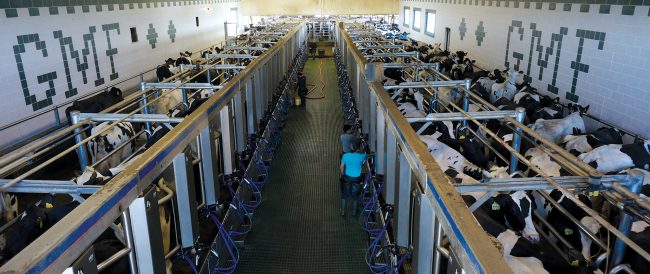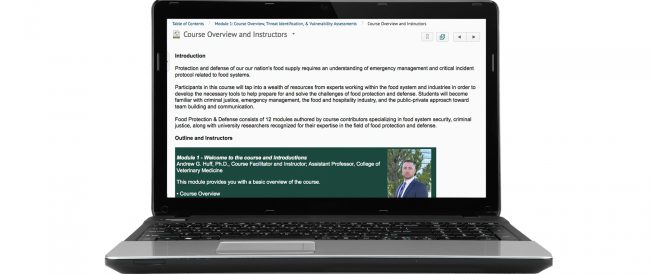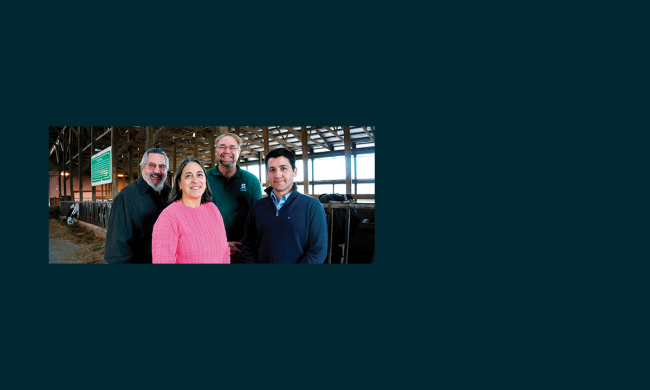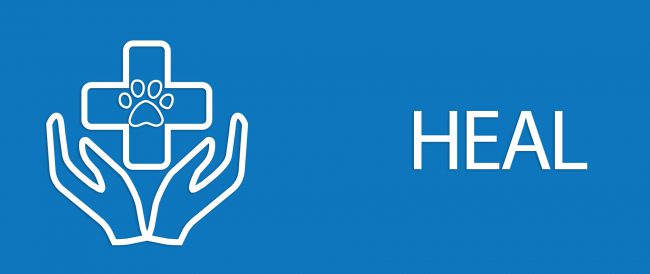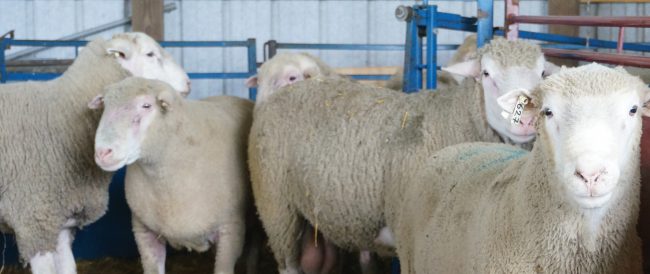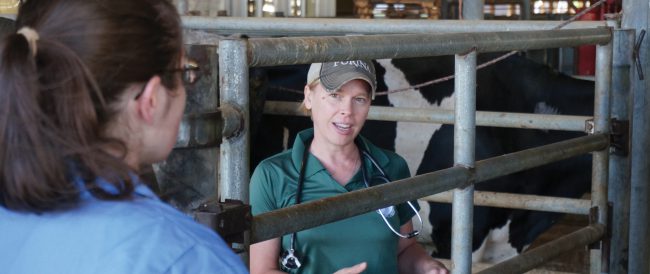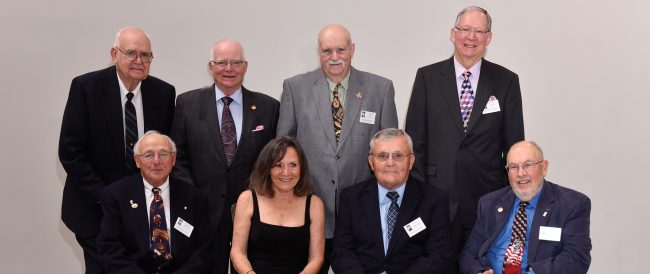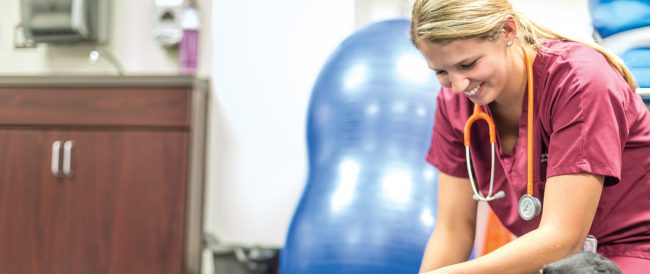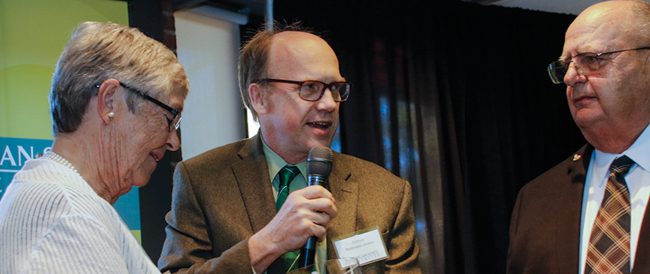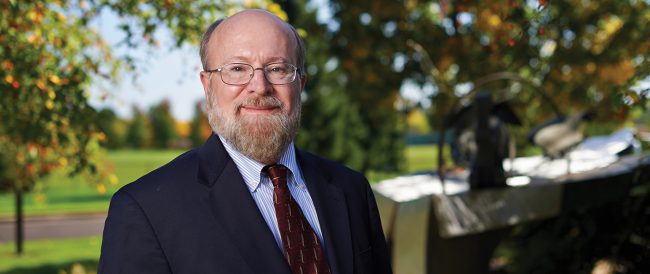 Read More
Read More
Hospital Focuses on Prevention for Welfare and Food Safety.
The MSU Veterinary Medical Center’s Large Animal Clinic works with farmers, animal owners, and their sick or injured food animals through emergency services, specialty and preventative medicine, and surgery. The Hospital is a well-known asset throughout Michigan and nationally; however, the Veterinary Medical Center is not the only place MSU’s food animal veterinarians make an impact.
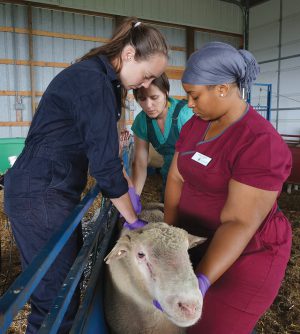
The Hospital provides healthcare and welfare support for all of the University’s animal agriculture farms. Dr. Vengai Mavangira, MSU Farms veterinarian and assistant professor for the Department of Large Animal Clinical Sciences, says the College’s focus on herd health benefits the animals, farmers, students, and the public.
“When we focus on herd health, we are making tremendous efforts to reduce the number of animals that become ill, as well as reducing the degree of illness for the few that become ill, in the interest of animal welfare and food safety,” says Mavangira. “Students benefit from directly participating in implementation of the programs for improving animal health at MSU. Our learning opportunities also provide producers and the public with knowledge on best practices for managing the health and welfare of their own animals.”
Faculty from the College regularly support the University’s south campus farms: the Sheep, Swine, Poultry, Beef, and Dairy Teaching and Research Centers, as well as the Student Organic Farm. They provide services that include overall herd health, surveillance, and emergency surgery and medicine.
“Our goal is to heal herds by preventing them from needing to be healed in the first place, as much as possible,” says Dr. Jennifer Roberts, assistant professor for the Department of Large Animal Clinical Sciences and clinician for the Hospital’s Large Animal Theriogenology Service.
In the early afternoon, sunlight streams into the Sheep Teaching and Research Center. Roberts and fourth-year DVM student Krysta Haggins begin unloading equipment. They are meeting with MSU farm employees to conduct breeding soundness examinations on rams.
“Having information that identifies which animals have the best breeding potential is an important aspect of herd animal health,” says Roberts, who is board-certified in theriogenology. “To keep a herd healthy, you need to give its young the best starting point possible. Breeding soundness exams allow us to do that.”
Better breeding decisions also have an economic impact. Farms producing healthier animals are more profitable.
“A focus on preventative medicine and herd health leads to fewer medical treatments because we are maintaining a healthier herd,” says Roberts.
Around 20 rams cluster together at the far side of the pen. Roberts looks up.
“I think we’re ready,” Roberts says. “Let’s grab the first one.”
The team works together to hold the first ram steady to perform a general physical examination. Then, they collect their sample and make their way to the microscope set up in the lab. Roberts watches as Haggins adds part of the sample to a slide.
“Okay, now we’re going to check for motility,” Roberts says to Haggins. “Then, morphology.”
Roberts watches as Haggins conducts her analysis, making written and verbal notes along the way.
“There’s good movement, and I don’t see a lot of deformity,” Haggins says. “So, this is a good sample.”
“Yes, he has good potential for breeding,” Roberts confirms.
Students from the College and the Department of Animal Science have clinical rounds and employment opportunities at MSU’s farms. This partnership highlights the interaction between clinical medicine and research with the primary goal of improving animal health.
“Hands-on work is a huge part of how we teach the students, but so are the discussions we have together,” says Roberts. “We provide a high level of care while focusing on animal welfare. That’s a huge part of veterinary medicine, no matter if you’re working with small or large animals.”
“When we focus on herd health, we are making tremendous efforts to reduce the number of animals that become ill, as well as reducing the degree of illness for the few that become ill, in the interest of animal welfare and food safety.”
— Dr. Vengai Mavangira
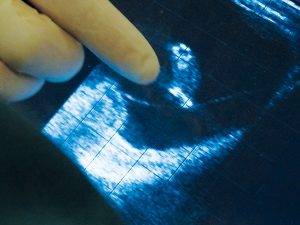
One student who has benefited from that model is Brandi Stone, a third-year DVM student. She spent the summer—and now alternate weekends—working at MSU’s dairy farm, the Dairy Teaching and Research Center. She focuses on calf management and helps with jobs like dehorning, storing colostrum, administering vaccines, and feeding.
“We also get to name the female calves, and this summer, I finally got one named after me!” Stone says. “She’s beautiful. She’s set to enter the milking herd when I graduate from veterinary school.”
The MSU dairy farm functions through a rigorous set of protocols, and according to Stone, each one is aimed toward herd health and animal welfare. Protocols exist for sick and recovering cows, calf management, treatment plans, antibiotic management, and hygiene and sanitation, among other things.
“Learning and performing these protocols has helped me expand my knowledge of herd health practices,” says Stone.
“Whether we’re working with an individual animal or researching ways to improve the health of a group of animals, healing the herd and welfare are at the core of our efforts.”
— Dr. Jennifer Roberts
Stone says that her experience working on the dairy farm has reinforced her goal to focus her veterinary career on dairy practice and to contribute to public education about the dairy industry and farm management standards.
“Before I came to MSU for veterinary school, I worked at a dairy in northern Michigan. During fall of my freshman year, the farm was devastated by bovine tuberculosis—the state had to take and dispose of the cattle,” says Stone. “It was an extensive process—the herd was culled, everything had to be cleaned, and new fencing and other protective mechanisms were implemented to prevent wildlife that may carry TB from entering the farm. That experience has taught me how important herd health is, and why the partnership between the College and south campus farms is so crucial. I’ve developed a lot of grit while working in northern Michigan, and I’ve gotten to use that here at MSU. The dairy I worked for has since recovered and restarted the farm. If they can do that, I know I can make it through veterinary school and affect change in my career.”
It is a foggy morning at the Dairy Teaching and Research Center. Roberts and Mavangira are working with a small group of students to perform pregnancy checks. Using an ultrasound, Roberts projects an image of one cow’s uterus on a portable tablet.
“See that?” Roberts asks, pointing at the screen. “We’ve got one.”
The students grin as the group moves on. Roberts palpates the next cow and then turns to the group.
“One of you palpate this cow and tell me what you find.”
One student steps forward and begins the examination. “I think she’s pregnant.”
“Right,” says Roberts. “How can you tell?”
“There’s fluid in the uterus, and I felt the fetus move,” says the student.
Roberts nods. “Excellent.”
In addition to clinical services, the College works to heal herds of animals through research. One such study is on bovine leukosis virus (BLV), which causes high levels of white blood cells. Overall, BLV affects 30–40 percent of the US cattle population and has been shown to decrease cow longevity in the herd.
“BLV has been shown to cause economic loss in the dairy industry,” says Daniel Grooms, chair for the Department of Large Animal Clinical Sciences, who is working on the study with Drs. Paul Bartlett, Jennifer Roberts, Ronald Erskine, Bo Norby, and Lorraine Sordillo, among others. “This can occur through decreased production, decreased life span, and carcass condemnation at slaughter.”
While the immediate economic loss is apparent, the team is investigating other less obvious impacts that BLV may have on herd health and production costs.
“We’re looking for things that are a bit more insidious,” says Grooms. “That’s a focal point, finding out which other factors may be impacted by the virus.”
And the team has identified a correlation: milk production.
“Looking at herd data, we’re noticing a trend that for every 10 percent increase in BLV herd prevalence, there’s a decrease in milk production,” says Erskine, a professor for the Department of Large Animal Clinical Sciences. “The industry has known about BLV for years, but [it] was never a major concern because the only visible loss was the condemned carcasses. Now that we’re investigating the other possibilities, there’s an increased sense of urgency to evaluate all losses and develop strategies to intercept them.”

On the agenda are tagging and testing heifers who have recently arrived in Michigan. This group of beef heifers are part of the College’s work to expand BLV research to beef cattle in addition to dairy cattle. The heifers line up one-by-one. While Roberts attaches the radio-frequency identification (RFID) ear tags, graduate student Oscar Benitez draws blood samples from the tails to test for BLV.
“Once we have each cow numbered and a BLV status for each, we’re going to begin testing to see if BLV is sexually transmissible,” says Roberts. “If it is, protocols can be developed that will help lessen the spread of BLV within the herd.”
The next heifer steps up. Before the chute closes, the heifer bolts and slips through. Roberts laughs and turns to the chute operator.
“Looks like you’re buying dinner,” she jokes.
“Now that we’re investigating the other possibilities, there’s an increased sense of urgency to evaluate all losses and develop strategies to intercept them.”
— Dr. Ronald Erskine
Management practices on the farm are equally as important as research projects. But regardless of whether the work is clinical or research based, the Hospital and College are constantly working to heal herds of food animals.
“We’re focused on short- and long-term solutions,” says Roberts. “Whether we’re working with an individual animal or researching ways to improve the health of a group of animals, healing the herd and welfare are at the core of our efforts.”



